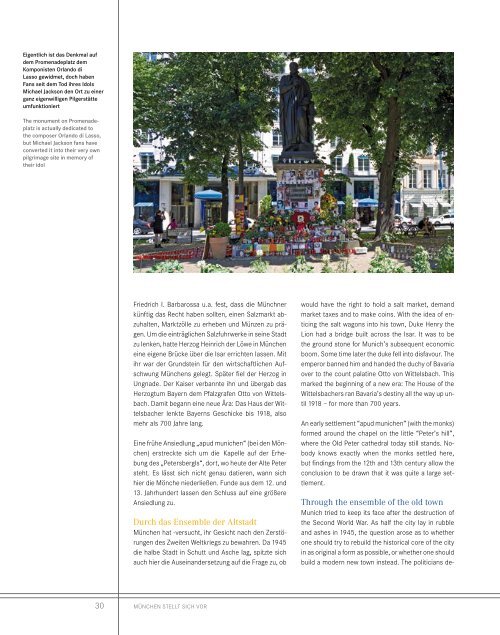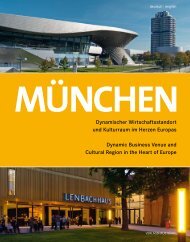München - Dynamischer Wirtschaftsstandort und Kulturraum im Herzen Europas
Create successful ePaper yourself
Turn your PDF publications into a flip-book with our unique Google optimized e-Paper software.
Eigentlich ist das Denkmal auf<br />
dem Promenadeplatz dem<br />
Komponisten Orlando di<br />
Lasso gewidmet, doch haben<br />
Fans seit dem Tod ihres Idols<br />
Michael Jackson den Ort zu einer<br />
ganz eigenwilligen Pilgerstätte<br />
umfunktioniert<br />
The monument on Promenadeplatz<br />
is actually dedicated to<br />
the composer Orlando di Lasso,<br />
but Michael Jackson fans have<br />
converted it into their very own<br />
pilgr<strong>im</strong>age site in memory of<br />
their idol<br />
Friedrich I. Barbarossa u.a. fest, dass die Münchner<br />
künftig das Recht haben sollten, einen Salzmarkt abzuhalten,<br />
Marktzölle zu erheben <strong>und</strong> Münzen zu prägen.<br />
Um die einträglichen Salzfuhrwerke in seine Stadt<br />
zu lenken, hatte Herzog Heinrich der Löwe in <strong>München</strong><br />
eine eigene Brücke über die Isar errichten lassen. Mit<br />
ihr war der Gr<strong>und</strong>stein für den wirtschaftlichen Aufschwung<br />
<strong>München</strong>s gelegt. Später fiel der Herzog in<br />
Ungnade. Der Kaiser verbannte ihn <strong>und</strong> übergab das<br />
Herzogtum Bayern dem Pfalzgrafen Otto von Wittelsbach.<br />
Damit begann eine neue Ära: Das Haus der Wittelsbacher<br />
lenkte Bayerns Geschicke bis 1918, also<br />
mehr als 700 Jahre lang.<br />
Eine frühe Ansiedlung „apud munichen“ (bei den Mönchen)<br />
erstreckte sich um die Kapelle auf der Erhebung<br />
des „Petersbergls“, dort, wo heute der Alte Peter<br />
steht. Es lässt sich nicht genau datieren, wann sich<br />
hier die Mönche niederließen. F<strong>und</strong>e aus dem 12. <strong>und</strong><br />
13. Jahrh<strong>und</strong>ert lassen den Schluss auf eine größere<br />
Ansiedlung zu.<br />
Durch das Ensemble der Altstadt<br />
<strong>München</strong> hat -versucht, ihr Gesicht nach den Zerstörungen<br />
des Zweiten Weltkriegs zu bewahren. Da 1945<br />
die halbe Stadt in Schutt <strong>und</strong> Asche lag, spitzte sich<br />
auch hier die Auseinandersetzung auf die Frage zu, ob<br />
would have the right to hold a salt market, demand<br />
market taxes and to make coins. With the idea of enticing<br />
the salt wagons into his town, Duke Henry the<br />
Lion had a bridge built across the Isar. It was to be<br />
the gro<strong>und</strong> stone for Munich’s subsequent economic<br />
boom. Some t<strong>im</strong>e later the duke fell into disfavour. The<br />
emperor banned h<strong>im</strong> and handed the duchy of Bavaria<br />
over to the count palatine Otto von Wittelsbach. This<br />
marked the beginning of a new era: The House of the<br />
Wittelsbachers ran Bavaria’s destiny all the way up until<br />
1918 – for more than 700 years.<br />
An early settlement “apud munichen” (with the monks)<br />
formed aro<strong>und</strong> the chapel on the little “Peter’s hill”,<br />
where the Old Peter cathedral today still stands. Nobody<br />
knows exactly when the monks settled here,<br />
but findings from the 12th and 13th century allow the<br />
conclusion to be drawn that it was quite a large settlement.<br />
Through the ensemble of the old town<br />
Munich tried to keep its face after the destruction of<br />
the Second World War. As half the city lay in rubble<br />
and ashes in 1945, the question arose as to whether<br />
one should try to rebuild the historical core of the city<br />
in as original a form as possible, or whether one should<br />
build a modern new town instead. The politicians de-<br />
30<br />
<strong>München</strong> stellt sich vor




